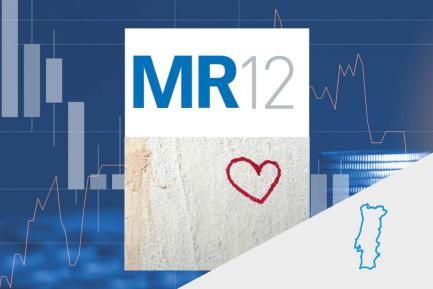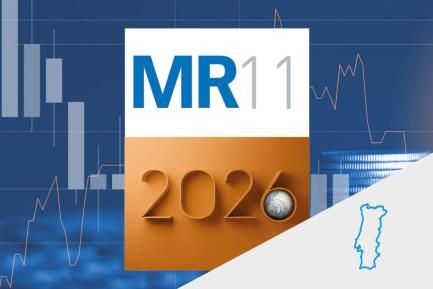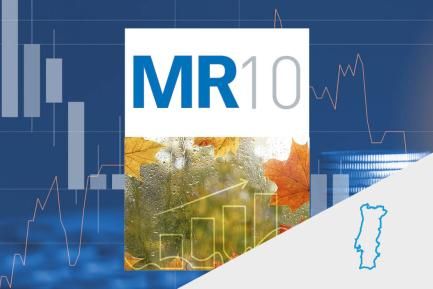
Despite the revival, COVID-19 continues to dictate the pace of the Portuguese economy
Following the revival of the summer, autumn started with a more mixed tone in economic activity
The GDP figures for Q2 confirmed a historic collapse in economic activity (–13.9% quarter-on-quarter and –16.3% year-on-year), although the lockdown had a somewhat less severe economic impact than initially anticipated. These figures lead us to adjust our GDP forecasts for 2020 as a whole to –10.0% (versus the previous forecast of –12.0%). However, this does not change the underlying picture: the pandemic is the major determinant of the economic scenario and it will continue to dictate the pace of economic activity until an effective vaccine and/or treatment is available. It is having a particularly significant impact on sectors such as tourism, which in Portugal accounts for a large part of economic activity (15% of GDP and 10% of employment in 2019). Thus, the recovery of the economy will be gradual and, in all likelihood, it will take years to reach pre-pandemic levels of activity. Indeed, the economic indicators suggest that the economy faces the autumn having achieved only an incomplete revival of its productive capacity. For instance, services turnover, industrial production and construction activity have been gradually recovering, yet they remain between 15% and 5% below pre-COVID levels. The latest sentiment indicators also reflect a mixed tone. In September, the economic climate indicator improved once again, driven by services and construction, but both the sentiment index for the industrial sector and the consumer confidence index deteriorated slightly. All in all, the coincident indicator for aggregate activity suggests that GDP will have rebounded significantly in Q3 compared to Q2, but it will still remain some 10% below the levels registered a year ago.

The impact of the COVID-19 crisis gradually filters through the labour market
The number of people registered as unemployed in job centres reached 409,331 in August, 2,029 more than in July and 93,769 more than at the start of the pandemic. In addition, preliminary data from the National Statistics Institute of Portugal suggest an increase in the unemployment rate in August up to 8.1%. By sector, this increase in unemployment was significant in the real estate, administrative and support service sectors, as well as in sectors associated with tourism (retail, and accommodation and catering), which are responsible for more than half of the increase in unemployment compared to the pre-pandemic figures from February. Finally, in July, the total number of hours worked remained 26% below the figure for February.

The external accounts deteriorate
In July, the current account deficit increased to –0.8% of GDP (1,536.5 million on a 12-month cumulative basis). In year-on-year terms, this represents an increase in the deficit of 990 million euros, largely due to the collapse in international tourism. Although part of the current account has shown improvement due to the decline in the oil price (compared to July 2019) and the fact that imports of goods have fallen by much more than exports, based on data up to July the tourism balance had decreased by 3,921 million euros and subtracted almost 2 pps of GDP from the total external balance.

The tourism sector remains heavily affected by the pandemic
In July, the number of tourists was 64% below the figures recorded in July 2019, largely reflecting a 74% year-on-year drop in foreign tourism. The picture for August is expected to have been slightly rosier due to the opening of the travel corridor with the United Kingdom, a very important market for the Portuguese tourism sector. However, this corridor was closed again in September following new coronavirus outbreaks in Europe, and all the indicators suggest that tourism will remain heavily affected in the last months of the year.
Savings increase due to the restrictions and uncertainty about the environment
In Q2, the household savings rate increased to 10.6% (+3.1 pps compared to Q1). This increase reflected a greater fall in consumption (held back both by
the restrictions on mobility and by households taking greater precautions in an uncertain environment) than in disposable household income (which was cushioned by supportive economic policies such as the deferral of tax payments, moratoriums on loan repayments and aid provided as part of the temporary workforce reduction programmes).

The general government deficit increases as a result of the fight against the pandemic
In August, the general government balance stood at –4.8% of GDP. This represents a clear decline compared to 2019 (in August last year there was a surplus of +0.3%) due to the measures introduced to help households and businesses cope with the economic impact of the COVID-19 crisis. The deficit reflects both an increase in total general government expenditure (+4.9% year-on-year in August) and a fall in revenues (–6.6% year-on-year). Over the coming months, the fight to contain the pandemic and the incomplete revival of economic activity will continue to weigh on the public accounts. Nevertheless, in September
the European Council approved the granting of 5,900 million euros to Portugal as part of the SURE European loan programme (European funds to cover costs related to temporary workforce reduction programmes and other similar labour-related measures), which will help to cover a portion of the general government’s funding needs generated by the COVID-19 pandemic.

Housing prices slow down
In Q2 2020, the home price index rose by 0.8% quarter-on-quarter (7.8% year-on-year). While still showing growth, this represents a sharp slowdown compared to Q1 (4.9% quarter-on-quarter and 10.3% year-on-year). This slowdown should continue over the coming months, as a result of demand being weakened by uncertainty in the current economic context. This weaker demand can be seen, for instance, in the 21.6% year-on-year fall in home sales in Q2, driven by the sharp contraction in economic activity in April and May.



